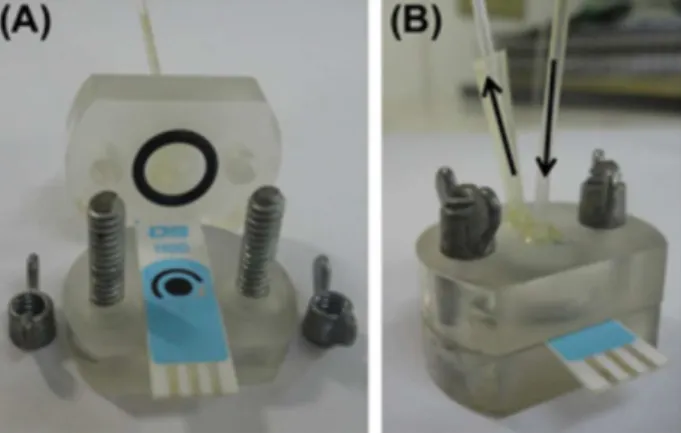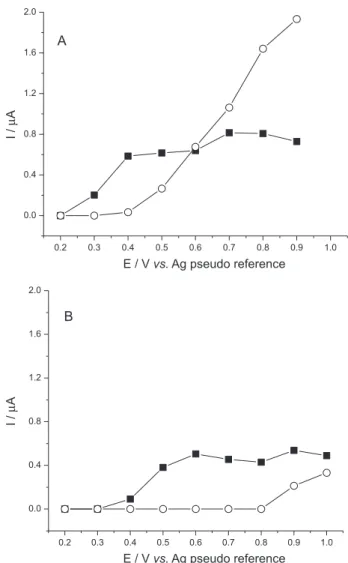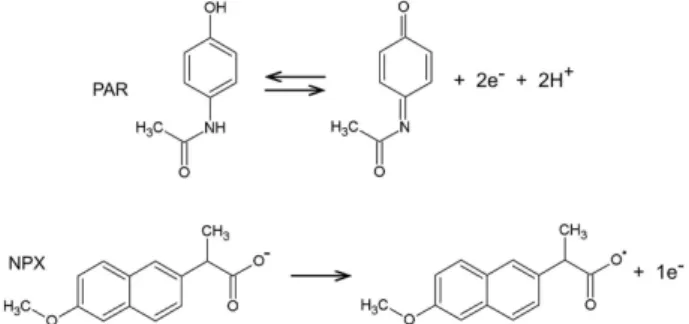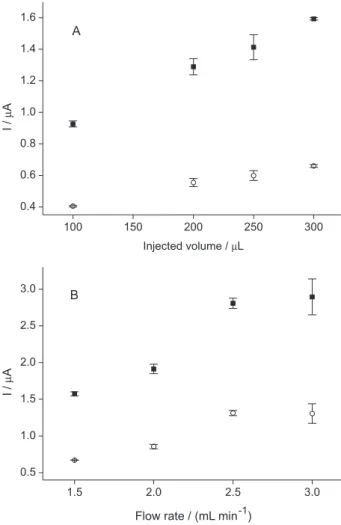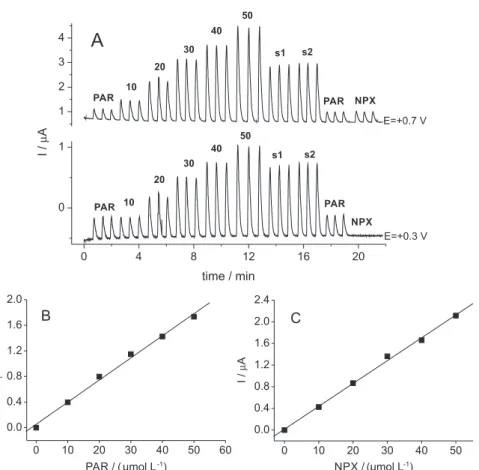Article
J. Braz. Chem. Soc., Vol. 25, No. 3, 484-491, 2014. Printed in Brazil - ©2014 Sociedade Brasileira de Química 0103 - 5053 $6.00+0.00
A
*e-mail: raamunoz@iqufu.ufu.br
Flow-Injection Analysis with Multiple-Pulse Amperometry for Simultaneous
Determination of Paracetamol and Naproxen Using a Homemade Flow Cell for
Screen-Printed Electrodes
Jessica S. Stefano, Rodrigo H. O. Montes, Eduardo M. Richter and Rodrigo A. A. Muñoz*
Instituto de Química, Universidade Federal de Uberlândia, Av. João Naves de Ávila 2121, Bloco 1D, 38400-902 Uberlândia-MG, Brazil
Este trabalho reporta a determinação simultânea de paracetamol e naproxeno usando a detecção amperométrica de múltiplos pulsos em um eletrodo impresso modificado com nanotubos de carbono de parades múltiplas (MWCNT-SPE) adaptado em uma célula de análise em fluxo (FIA) construída em laboratório. Uma sequência de dois pulsos de potencial (+0,30 e 0,70 V por 70 ms cada) foi aplicada continuamente de tal forma que paracetamol foi selectivamente oxidado em +0,30 V e ambos compostos (paracetamol e naproxeno) são oxidados em +0,70 V. Subtração da corrente depois de usar um fator de correção foi empregada para a determinação de naproxeno sem a interferência do paracetamol. O método FIA proposto apresenta alta seletividade e sensibilidade, exatidão adequada (resultados em concordância com cromatografia líquida de alta eficiência), elevada frequência analítica (90 h-1) e baixo custo uma vez que um único SPE pode ser usado
durante todo o dia de trabalho adaptado em uma célula em fluxo.
This work reports the simultaneous determination of paracetamol and naproxen using multiple-pulse amperometric detection on a multi-walled carbon nanotube modified screen-printed electrode (MWCNT-SPE) adapted in a homemade flow-injection analysis (FIA) cell. A sequence of two potential pulses (+0.30 and +0.70 V for 70 ms each) was applied continuously in such a way that paracetamol is selectively oxidized at +0.30 V and both compounds (paracetamol and naproxen) are oxidized at +0.70 V. Current subtraction after using a correction factor was employed for determination of naproxen without the interference of paracetamol. The proposed FIA method presents high selectivity and sensitivity, adequate accuracy (results in agreement with high-performance liquid chromatography), elevated analytical frequency (90 h-1), and low-cost
once a single SPE strip can be used during the whole working day adapted in a flow-cell.
Keywords: carbon nanotubes, pharmaceutical formulations, flow analysis, acetaminophen,
non-steroidal anti-inflammatory drug
Introduction
Paracetamol [acetaminophen or N-acetyl amino phenol] is widely used as an antipyretic and analgesic drug. It is highly effective for the release of pain associated with arthralgia, neuralgia, and headache and even for patients suffering from gastric symptoms and in many countries it has been used as a substitute for aspirin [acetyl salicylic acid].1 Naproxen, (+)-2-(6-methoxy-2-naphthyl)propionic
acid, is extensively used in non-steroidal anti-inflammatory cures such as the treatment of rheumatoid arthritis, dysmenorrhea and acute gout.2 The combination of
paracetamol and nonsteroidal anti-inflammatory drugs such as naproxen has proven efficacy in the treatment of pain conditions and has its clinical use validated.3 Association
therapy with paracetamol and naproxen has also been reported to benefit patients who have pain associated with rheumatoid arthritis.4,5
Therefore, the determination of naproxen and paracetamol is relevant in pharmaceutical formulations as well as in biological fluids. Several methods mainly based on spectrofotometry, spectrofluorimetry or electroanalysis were reported for the single determination of paracetamol6-8
or naproxen.9-11 However, to our knowledge, few analytical
high-performance liquid chromatography (HPLC)12,13
and voltammetry.14 Therefore, the development of new
methods for simultaneous determination of paracetamol and naproxen remains a topic to be explored.
Flow-injection analysis with multiple-pulse amperometric (FIA-MPA) systems can be used for simultaneous determinations using a single working electrode. This strategy was used for the simultaneous determination of sugars,15 drugs,16-19 antioxidants,20
synthetic colorants,21 as well as the possibility of using the
internal standard method in FIA systems.22
Screen-printed electrodes (SPE) are planar devices which contain the three electrodes (working, counter and pseudo-reference) which typically are used in electrochemical cells. This setup is usually indicated for onsite analysis because of its characteristics such as low power requirement, quick response, high sensitivity and ability to operate at room temperature.23,24 In addition,
the presence of the three electrodes on the same device facilitates the positioning of these electrodes in a flow cell.25
In this work, we demonstrate that FIA-MPA detection on a multi-walled carbon nanotube modified screen-printed electrode (MWCNT-SPE) can be used for the simultaneous determination of naproxen and paracetamol in pharmaceutical formulations. Results obtained from this novel FIA-MPA method using a homemade flow-cell were evaluated with respect to linearity, repeatability, recovery, detection and quantification limits, and by comparison with results from HPLC analysis.
Experimental
Reagents and samples
Highly pure deionized water (R ≥ 18 MΩ cm) obtained from a Millipore Direct-Q3 water purification system (Bedford, MA, USA) was used to prepare all aqueous solutions. Analytical grade phosphoric acid (85% m/v) from Impex (São Paulo, Brazil), oxalic acid from Reagen (Rio de Janeiro, Brazil), boric acid from QM (Cotia, Brazil), glacial acetic acid from Carlo Erba (Milan, Italy), sodium hydroxide from Dinamica (Diadema, Brazil), methanol (HPLC grade) from Proquimios (Rio de Janeiro, Brazil), paracetamol from Synth (Diadema, Brazil) and naproxen from DEG (São Paulo, Brazil) were used without further purification. Stock solutions of naproxen and paracetamol were freshly prepared just before the experiments by dilution in electrolyte.
Two different pharmaceutical formulations (in capsules) were obtained from local drug stores. For each analysis, the total amount of powder in three capsules (each capsule contains 275 mg naproxen and 300 mg paracetamol and
excipients) from the same blister was mixed. An adequate amount of powder was dissolved in electrolyte (0.1 mol L-1
phosphate buffer at pH 7.5), after stirring and sonication for 10 min in ultrasonic bath. The samples and standard solutions were further diluted in electrolyte for subsequent injection in the FIA system.
Electrochemical measurements
All electrochemical measurements were performed using a µ-Autolab Type III (Eco Chemie, Utrecht, Netherlands). All experiments were performed using commercial SPEs, which include a three-electrode configuration printed on the same strip (DRP-110CNT, DropSens). The strips (3.4 × 1.0 × 0.05 cm) presented a 4 mm diameter disk multi-walled carbon nanotubes screen-printed (MWCNT-SPE) as working electrode (WE), a carbon counter electrode (CE), and a silver pseudoreference electrode (RE). MWCNT-SPE are produced with carboxyl functionalized MWCNTs that enhances the electrochemical active area and electronic transfer properties.26 For comparison, unmodified carbon
screen-printed electrodes (C-SPEs) were also evaluated. All SPEs already assembled in the flow cell were just cycled (3 cyclic voltammograms) in the range of 0.0 to 1.0 V in order to check their typical electrochemical behavior in supporting electrolyte before amperometric measurements.
A homemade wall-jet flow cell was designed to adapt SPEs to perform FIA with amperometric detection (Figure 1). An SPE strip is firmly placed between two acrylic blocks (the bottom block contains a small ledge to position the strip) and an O-ring (d = 10 mm) is used to limit the inner volume (~90 µL) covering the three electrodes. The upper block contains two holes to allow solution inlet (90o – wall-jet configuration) and outlet (45o). The
electrochemical flow cell was inserted in a one-channel FIA system, which was assembled with a peristaltic pump and a manual injector made of acrylic. A single-line flow
system was employed using 1.0 mm (i.d.) polyethylene tubing. A 0.1 mol L−1 phosphate buffer solution (adjusted to
pH 7.5) was used as the carrier solution. All electrochemical measurements were performed at room temperature in the presence of dissolved oxygen.
HPLC analysis
The HPLC measurements were performed using a Shimadzu LC-10 VP equipped with a UV-vis detector (SPD-10AV), an LC column (Lychrispher 100 A8 RP18-C18, 250 mm × 4.6 mm, 5 mm), a degasser (DGU-20A5), a manual injector (20 µL) and a pump (LC-10AD-VP). The mobile phase consisted of a mixture of water and methanol (70:30, v/v). The detector was fixed at 263 nm. The flow rate was 1.0 mL min-1. This analytical
protocol was adpated from a previous work.12
Results and discussion
The electrochemical oxidation of paracetamol and naproxen at MWCNT-SPE was investigated in 0.1 mol L-1
Britton-Robinson (BR) buffer solutions (from pH 2.0 to 10.0) and in a 0.1 mol L-1 phosphate buffer solution
(pH = 7.5), which was the optimized electrolyte for the amperometric determination of naproxen at a glassy-carbon electrode as described in the literature.11,14 The 0.1 mol L-1
phosphate buffer solution was selected for further experiments because under this condition the oxidation peaks of paracetamol and naproxen were well-separated (300 mV) in the cyclic voltammetry experiments. Moreover, negligible response for naproxen was observed in acidic solutions as described in the literature.11 These
results are in accordance with a previous work which investigated the voltammetric profile of naproxen and paracetamol in phosphate buffer.14 Figure 2A highlights
the hydrodynamic voltammograms for the oxidation of paracetamol and naproxen at MWCNT-SPE assembled on the homemade flow-cell using a 0.1 mol L-1 phosphate
buffer carrier solution. In this study, standard solutions containing 10 µmol L-1 paracetamol or 10 µmol L-1
naproxen were injected (n = 3) in the FIA system with MPA detection. Eight fast (70 ms each) potential pulses (0.20, 0.30, 0.40, 0.50, 0.60, 0.70, 0.80 and 0.9 V) were applied continuously and the current at each potential pulse (simultaneous acquisition of 8 amperograms) was monitored continuously. The respective current peak at each potential pulse was measured and used to construct the hydrodynamic voltammogram for the electrochemical oxidation of both compounds separately. For comparison, hydrodynamic voltammograms for the oxidation of
paracetamol and naproxen at unmodified carbon SPE were also obtained under the same conditions (Figure 2B).
Under hydrodynamic conditions, the oxidation current of paracetamol started to increase at approximately +0.3 V and reached a plateau near +0.7 V, while the oxidation current of naproxen started at +0.5 V at MWCNT-SPE. On the other hand, the oxidation of paracetamol and naproxen at C-SPE (unmodified carbon SPE) occurred at +0.4 V and +0.9 V, respectively. Therefore, the presence of MWCNTs within the carbon SPE improved the response of both analytes either by current increase or by lowering the oxidation potentials. However, a remarkable improvement was verified for the electrochemical oxidation of naproxen at MWCNT-SPE with a 10-fold increase in current and a 400 mV decrease in the overpotential of oxidation reaction. Figure 2. Hydrodynamic voltammograms obtained by plotting peak
current values as function of the corresponding applied potential pulses registered at (A) a MWCNT-SPE and (B) a C-SPE. () Injections of 10 µmol L-1 paracetamol; () Injections of 10 µmol L-1 naproxen. Potential
pulse time: 70 ms each; supporting electrolyte: 0.1 mol L-1 phosphate
Thus, this comparison between unmodified carbon SPE and MWCNT modified carbon SPE clearly showed the enhanced electronic transfer properties of MWCNTs towards naproxen oxidation.
The mechanism of the electrochemical oxidation of naproxen was previously investigated.11 The proposed
mechanism involves a single-electron transfer via radical cation formation (considering the protonated form of naproxen), followed by decarboxylation (fast chemical reaction)27, and is not pH-dependent.11 As previously
described,28-30 the electrooxidation of paracetamol involves
the transfer of two electrons and two protons, generating N-acetyl-p-quinoneimine. The mechanisms of oxidation of paracetamol and naproxen are illustrated in Figure 3.
The electroactive area of both SPEs was calculated using Randles-Sevcik equation for a reversible electrochemical process under diffusion control (ferricyanide/ferrocyanide). The average electroactive areas (n = 3) of MWCNT-SPE and C-SPE was 0.096 and 0.063 cm2, respectively, while
the geometrical area of working electrode is 0.126 cm2.
Therefore, the electroactive area of MWCNT-SPE and C-SPE corresponds to 76% and 50% of the geometrical area which indicates a partial blockage of the working electrode area in both SPEs that may be attributed to contamination with residual organic binder of the carbon ink. On the other hand, the higher electroactive area of MWCNT-SPE in comparison with the C-SPE was expected due to the high surface area provided by the carbon nanotubes.
Since the purpose of this work is to perform the simultaneous determination of both compounds at a single amperometric run, the use of MPA is required and a sequence of two potential pulses was selected. According to the hydrodynamic voltammograms at MWCNT-SPE, the application of potentials lower than +0.4 V would promote the detection of paracetamol without naproxen interference, and so +0.3 V was selected as the first potential pulse (oxidation of naproxen only starts at +0.4 V). If potential values higher than +0.4 V were
employed, the electrochemical oxidation of paracetamol and naproxen would be verified. Then, a second potential pulse (+0.7 V) was selected at which both compounds were electrochemically oxidized. Both potential pulses were applied for 70 ms based on the highest analytical signal for paracetamol and naproxen. The oxidation current from naproxen was obtained by subtraction of the current values detected at the two potential pulses, similarly to previous studies which applied MPA for simultaneous determinations but using glassy-carbon or boron-doped diamond electrodes.31-34
It is worth mentioning that the oxidation currents of paracetamol did not present the same magnitude at the two potential pulses (+0.3 V and +0.7 V). The oxidation current of paracetamol at +0.7 V was higher than the current detected at + 0.3 V. Therefore, a simple subtraction between the currents detected at the two potential pulses does not directly yield the absolute value of naproxen oxidation current at +0.7 V. Since the selective determination of naproxen depends on subtraction of the paracetamol current due to its oxidation at +0.7 V, a correction factor (CF) need be calculated based on the ratio of the current responses to paracetamol oxidation (iPAR) registered at +0.3
and +0.7 V. This CF was obtained by injecting a solution containing only paracetamol in the FIA-MPA system and the following equation:
CF = iPARat+0.7V / iPARat+0.3V (1)
Then, if solutions or samples containing both compounds are injected in the FIA-MPA system, the current originating from naproxen oxidation detected at +0.7 V (i+0.7V) can be calculated using the CF value and the equation 2. The average CF value obtained by the injection of 10 µmol L-1
paracetamol was 1.2.
INPX = i+0.7V – (CF × iPARat+0.3V) (2)
FIA parameters were evaluated in order to obtain the highest signal for paracetamol and naproxen. Figure 4 presents the variation of peak current for paracetamol and naproxen oxidation in function of (A) injected volume and (B) flow rate.
A slight higher current and lower standard deviation (n = 3) was observed for an injection volume of 300 µL of 10 µmol L-1 of paracetamol + naproxen in the FIA-MPA
system (Figure 4A), which was thus selected for further amperometric recordings. The flow rate of the FIA system (Figure 4B) was evaluated keeping constant the injection volume of 300 µL of 10 µmol L-1 of paracetamol
+ naproxen. It was observed a linear increase from 1.5 to Figure 3. Mechanism of oxidation of paracetamol (PAR) and naproxen
2.5 mL min-1. The flow rate of 2.5 mL min-1 was selected
for further amperometric measurements.
A repeatability study based on repetitive (n = 10) 300 µL injections of 10 µmol L-1 of paracetamol + naproxen in
phosphate buffer solution (pH = 7.5) was carried out using the same MWCNT-SPE strip (intra-day repeatability) The inter-day repeatability was evaluated based on the amperometric response of paracetamol and naproxen using different MWCNT-SPE strips in other working days (n = 3). Although a single MWCNT-SPE is a disposable source of electrodes, the same strip could be used for consecutive days in one week. The analytical characteristics
(also including linear dynamic ranges (LDR) and limits of detection (LOD)) of the proposed analytical method are summarised in Table 1. The analytical frequency estimated in this amperometric recording was 90 h-1.
The effect of some possible interfering substances (excipients in pharmaceutical formulations) including starch, hydroxypropyl methylcellulose, cellulose, titanium dioxide, magnesium stearate, talc, glucose, and citrate was evaluated by injecting solutions containing 1 mmol L-1 of
each excipient separately. No current peaks were obtained at both potentials after injection of all possible interfering substances, which indicates that paracetamol and naproxen can be accurately determined in pharmaceutical formulations.
The optimized FIA-MPA method was applied for the simultaneous determination of paracetamol and naproxen in pharmaceutical formulations. For comparison, the samples were also analyzed by HPLC including evaluation using Student’s t-test. The amperometric response for injections of standard solutions of paracetamol and naproxen (calibration curve) and samples (after adequate dilution) is presented in Figure 5. Recovery tests were performed by spiking both samples (after sample dissolution in electrolyte) with a standard solution containing 20 µmol L-1 of paracetamol and naproxen. All
results are presented in Table 2.
The calibration curves (Figures 5B and 5C) showed good linearity in the investigated concentration range with the following calibration equations:
Paracetamol: i (µA) = 0.05252 + 0.03459 c (µmol L-1); r = 0.997
Naproxen: i (µA) = 0.01629 + 0.04221 c (µmol L-1); r = 0.999
The limits of detection were estimated as 0.4 and 0.3 µmol L-1 for paracetamol and naproxen, respectively.
The results obtained by the proposed FIA-MPA method were in agreement with those obtained by HPLC at the 95% confidence level (the calculated t-values from Student’s t-test were smaller than the critical value, 2.78, for n = 4), attesting the accuracy of the proposed method. These results attest to the good performance of the new Figure 4. Optimization of FIA parameters: variation of (A) injected
volume (100, 200, 250, and 300 µL) and (B) flow rate (1.5, 2.0, 2.5, and 3.0 mL min-1) based on triplicate injections of 10 µmol L-1 paracetamol ()
and 10 µmol L-1 of paracetamol + naproxen (). Electrolyte: 0.1 mol L-1
phosphate buffer solution (pH = 7.5).
Table 1. Analytical characteristics of the proposed method
Analytes LDR / (µmol L-1) Sensitivity / (µA L µmol-1) LOD / (µmol L-1) Intra-day RSD / % Inter-day RSD / %
Paracetamol 10-800 0.042 0.4 1.0 8.5
Naproxen 10-400 0.036 0.3 1.0 9.0
FIA-MPA method for simultaneous determination of paracetamol and naproxen using an MWCNT-SPE. The proposed FIA-MPA method was compared with previous methods reported in the literature (Table 3). The proposed method presented superior performance in comparison with HPLC. The square-wave voltammetric method which employed a dysprosium nanowire-modified carbon paste electrode provided better detection limits (at least 3 orders of magnitude) due to the high sensitivity of square-wave voltammetry associated with a preconcentration step. On the other hand, the modified carbon paste electrode required polishing and cleaning before each measurement, which increases the analysis time and this additional step depends on analyst skills. Thus, the analytical frequency of such a
voltammetric method is dramatically decreased to 30 h-1
considering a one-minute electrode polishing/cleaning step and a one-minute measurement.
Conclusions
The present study demonstrates that MWCNT-SPE is a promising analytical tool in FIA system coupled to MPA detection, which can be used as a simple sensor for the simultaneous quantification of paracetamol and naproxen in pharmaceutical formulations. The technique presented short analysis time (90 injections per h), low consumption of reagents and samples, high precision (RSD < 1.1%; n = 10), adequate accuracy (confirmed by Table 2. Comparison of the analytical results obtained by FIA-MPA and HPLC for simultaneous determination of paracetamol (PAR) and naproxen (NPX)
in pharmaceutical formulations (n = 3), respective recovery tests (n = 3) and calculated t-values
Samples Analyte Label value /
(mg per capsule)
FIA-MPA / (mg per capsule)
HPLC /
(mg per capsule) Recovery / % Calculated t-values A NPXPAR 300275 282 ± 6250 ± 6 282 ± 14249 ± 17 99 ± 598 ± 4 0.0000.096
B PAR
NPX
300 275
293 ± 3 263 ± 3
300 ± 10 269 ± 4
105 ± 6 113 ± 8
1.162 2.076
Figure 5. (A) FIA-MPA registered at +0.3 and +0.7 V (70 ms each) for triplicate injections of solution containing only 10 µmol L-1 paracetamol (PAR) or
only 10 µmol L-1 naproxen (NPX), 5 solutions containing simultaneously increasing concentrations of paracetamol and naproxen (from 10 to 50 µmol L-1),
comparison with HPLC results), and linear calibration curves (r > 0.99 in both cases). The limits of detection were 0.4 and 0.3 µmol L-1 (FIA) for paracetamol and naproxen,
respectively. Furthermore, the method is selective for simultaneous determinations, free of interferences from sample matrix, requires simpler instrumentation and provides lower analytical costs in comparison with HPLC (typically applied for simultaneous determinations in pharmaceutical analyses).
Acknowledgements
The authors are grateful to CNPq (308174/2013-5 and 472465/2012-0), FAPEMIG (CEX-PPM-00236-12 and CEX-PPM-00503-13) and CAPES for financial support.
References
1. Zen, J. M.; Ting, Y. S.; Anal. Chim. Acta1997, 342, 175. 2. Todd, P. A.; Clissold, S. P.; Drugs1990, 40, 91.
3. Miranda, H. F.; Puig, M. M.; Prieto, J. C.; Pinardi, G.; Pain
2006, 121, 22.
4. Seideman, P.; Samuelson, P.; Neander, G.; Acta Orthop. Scand.
1993,64, 285.
5. Seideman, P.; Br. J. Rheumatol. 1993, 32, 1077.
6. Mohamed, F. A; AbdAllah, M. A.; Shammat, S. M.; Talanta
1997, 44, 61.
7. Calatayud, J. M.; Benito, C. G.; Anal. Chim. Acta.1990, 231,
259.
8. Felix, F. S.; Angnes, L.; J. Pharmac. Sci.2010, 99, 4784.
9. Panderi, I.; Parissipoulou, M.; Analyst1994, 119, 697. 10. Damiani, P.; Bearzotti, M.; Cabezon, M. A.; J. Pharm. Biomed.
Anal.2002, 29, 229.
11. Lima, A. P.; Stefano, J. S.; Montes, R. H. O.; Richter, E. M.; Munoz, R. A. A.; J. Braz. Chem. Soc. 2012, 23, 1834. 12. Singh, K. B.; Waikar, S. B.; Padmane, S. P.; Internat. J. Pharm.
Sci. Research2012, 3, 3742 .
13. Pansara, V. H.; Kakadiya, M.; Saishivam; JPR: BioMedRx: An International Journal2013, 1, 633.
14. Norouzi, P.; Dousty, F; Ganjali, M. R.; Daneshgar, P.; Int. J. Electrochem. Sci. 2009, 4, 1373.
15. Surareungchai, W.; Deepunya, W.; Tasakorn, P.; Anal. Chim. Acta2001, 448, 215.
16. Lopes, A. C. V.; Luz, R. D. S.; Damos, F. S.; Santos, A. S.; Franco, D. L.; Santos, W. T. P.; J. Braz. Chem. Soc. 2012, 23,
1800.
17. Gimenes, D. T.; Santos, W. T. P.; Tormin, T. F.; Munoz, R. A. A.; Richter, E. M. Electroanalysis2010, 22, 74.
18. dos Santos, W. T. P.; de Almeida, E. G. N.; Ferreira, H. E. A.; Gimenes, D. T.; Richter, E. M.; Electroanalysis2008, 20, 1878. 19. dos Santos, W. T. P.; Gimenes, D. T.; de Almeida, E. G. N.;
Eiras, S. D.; Albuquerque, Y. D. T.; Richter, E. M.; J. Braz. Chem. Soc. 2009, 20, 1249.
20. Medeiros, R. A.; Lourencao, B. C.; Rocha, R. C.; Fatibello, O.;
Anal. Chem. 2010, 82, 8658.
21. Medeiros, R. A.; Lourencao, B. C.; Rocha, R. C.; Fatibello, O.;
Talanta 2012, 99, 883.
22. Gimenes, D. T.; Santos, W. T. P.; Munoz, R. A. A.; Richter, E. M.; Electrochem. Commun.2010, 12, 216.
23. Nascimento, V. B.; Angnes, L.; Quim. Nova1998, 21, 614. 24. Tse, Y. H.; Janda, P.; Lam, H.; Lever, A. B. P.; Anal. Chem.
1995, 67, 981.
25. Hsu, C. T.; Chung, H. H.; Lyuu, H. J.; Tsai, D. M.; Kumar, A. S.; Zen, J. M.; Anal. Sci.2006, 22, 35.
26. http://www.dropsens.com/en/pdfs_productos/new_ brochures/110cnt-c1110cnt.pdf accessed in November 2013. 27. Bosca, F.; Martinez-Manez, R.; Miranda, M. A.; Primo, J.;
Soto, J.; Vano, L.; J. Pharmac. Sci.1992, 81, 479.
28. Lourencao, B. C.; Medeiros, R. A.; Rocha, R. C.; Mazo, L. H.; Fatibello, O.; Talanta2009, 78, 748.
29. Miner, D. J.; Rice, J. R.; Riggin, R. M.; Kissinger, P. T.; Anal. Chem. 1981, 53, 2258.
30. Fanjul-Bolado, P.; Lamas-Ardisana, P. J.; Hernadez-Santos, D.; Costa-Garcia, A.; Anal. Chim. Acta2009, 638, 133.
Table 3. Comparison of analytical characteristics between the proposed method and other analytical methods
Analytical method Analytes LDR / (µmol L-1) LOD / (µmol L-1) Analytical frequency / h-1 Ref.
HPLC PAR 33-529 n. m. 8 12
NPX 13-209 n. m.
HPLC PAR 20-46 3.4 15 13
NPX 7.8-18.2 1.0
SWV PAR 0.01-250 0.0003 n. m. 14
NPX 0.001-500 0.0005
FIA-MPA PAR 10-800 0.4 90 This work
NPX 10-400 0.3
31. Silva, W. C.; Pereira, P. F.; Marra, M. C.; Gimenes, D. T.; Cunha, R. R.; Silva, R. A. B.; Munoz, R. A. A.; Richter, E. M.;
Electroanalysis2011, 23, 2764.
32. de Miranda, J. A. T.; Cunha, R. R.; Gimenes, D. T.; Munoz, R. A. A.; Richter, E. M.; Quim. Nova 2012, 35, 1459. 33. da Silva, R. A. B.; Gimenes, D. T.; Tormin, T. F.; Munoz,
R. A. A.; Richter, E. M.; Anal. Methods2011, 3, 2804.
34. Tormin, T. F.; Cunha, R. R.; Richter, E. M.; Munoz, R. A. A.;
Talanta2012, 991, 527.
